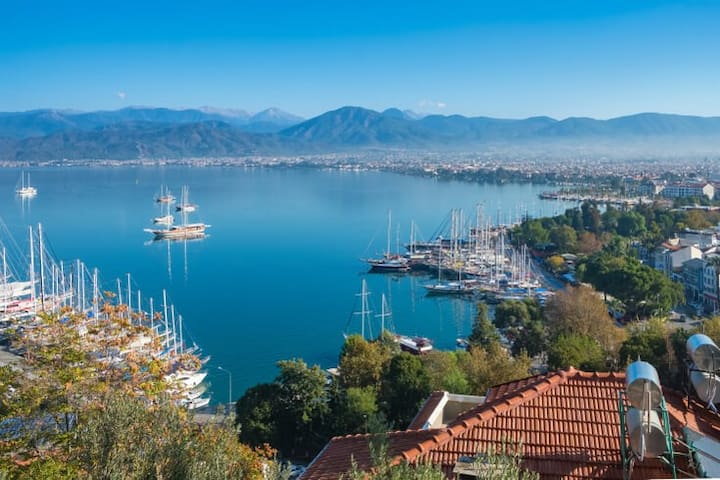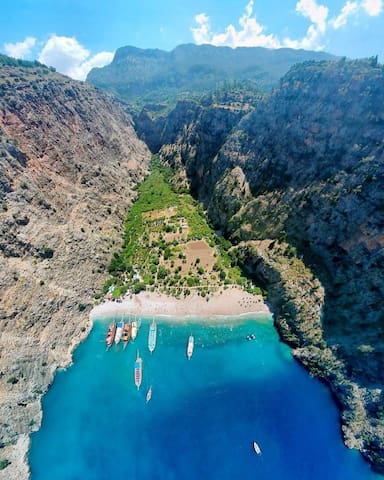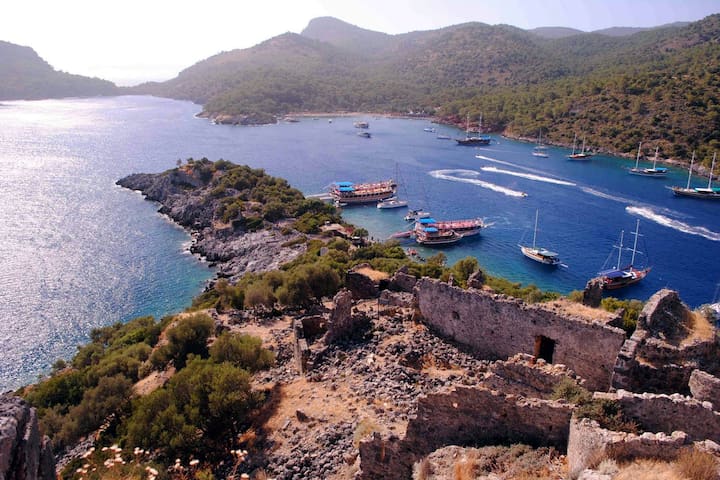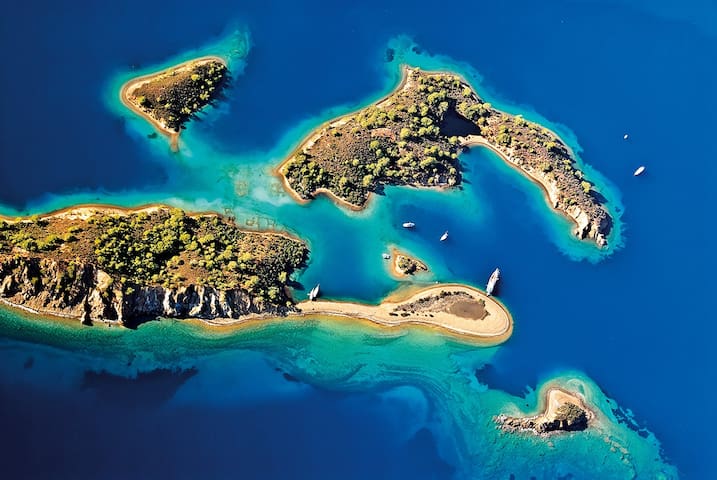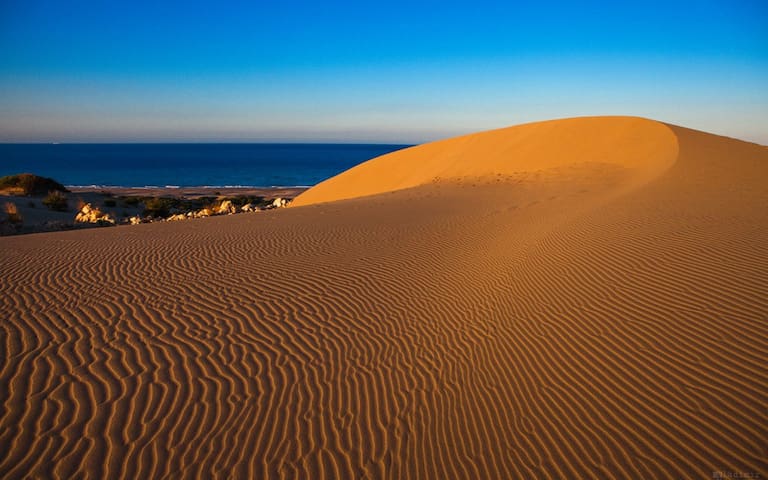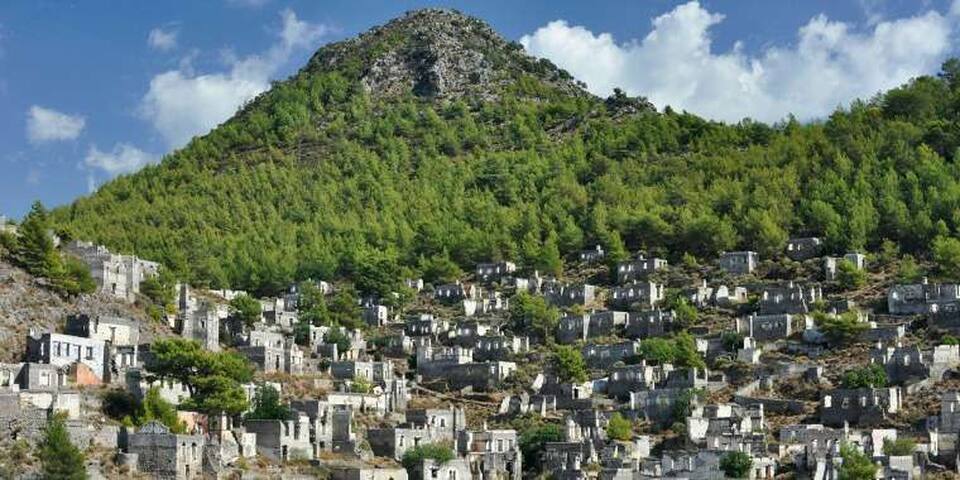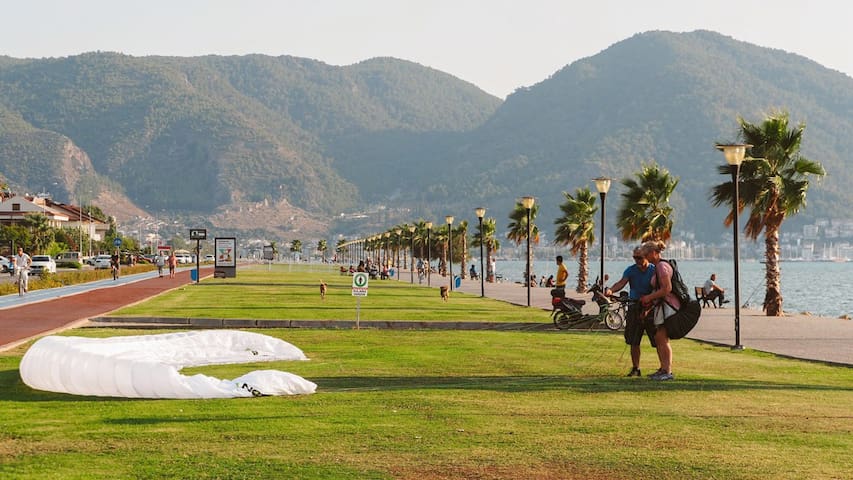City/town information
Stunning Fethiye is located in the heart of the Turkish Riviera. This ancient city, once named Telmessos, was the most important city of Lycia, with a history on record starting in the 5th century BC. The location of Fethiye is just one of the reasons it was voted number one for best tourism centre in the world by The Times and The Guardian in 2007. One of the other reasons is because it’s one of the best spots to begin a blue cruise on a traditional Turkish gulet.
Explore the vibrant market place or visit the Tomb of Aminthas cut high in the rocks of Fethiye, or continue on to Kayakoy "the ghost town", where the entire village is a standing museum containing many ancient Greek-style houses and churches that cover a mountainside. Historic ruins such as the Hellenistic theatre are located in the city centre and are currently being renovated in the hope of holding grand open-air concerts and operas under the stars.
Fethiye is a true treasure of the Mediterranean coast. It's located close to tourist hotspots such as the thermal springs of Pamukkale and the ancient wonders of Ephesus, but most importantly it's the ultimate jump-off point for sailing around the Mediterranean. From here you can begin to sail around Turkey in luxury exploring all the natural aquatic wonders this beautiful country has to offer. A trip to Olympos, Rhodes, and the Blue Cave are only a few of the magical places that are just a short sail away.
Things to do in Fethiye
Fethiye is both generous in sites and activities available for travellers. Here, your journey may begin at the ancient Lycian Rock Tombs of Amintas which are more than 2400 years old. You can gain fascinating views of the archipelago from the platforms of these massive tombs and the rest of Fethiye standing in the archway of this looming tomb.
Located down the mountain and tombs is the main yacht marina and the main jump-off point for the Fethiye to Kekova blue cruise. Travelling on a traditional Turkish gulet, there are cruises from three days to one week visiting the major highlights along the Lycian coastline including Butterfly Valley, Oludeniz, Kas, Kekova and the Sunken City. These types of cruises are one of the major highlights of not only Fethiye but all of Turkey.
Located in the centre of Fethiye, behind the harbour is the Telmessos' Roman theatre which has more than 6000 seats. It was built in the 2nd century BC and is currently being restored to its natural glory. Not far from the Roman theatre is the Fethiye Museum which contains many exhibits from the ancient settlements of Telmessos, Kaunos and Tlos. You can find many ancient pieces of jewellery, potteries, votive stones, few ancient Stelae and many other artefacts.
For those staying in Fethiye for longer periods of time, there is many day tours and trips to fill up your days. The first to mention is the Jeep Safari visiting inland sites including Saklikent Gorge, local mud baths, Yaka Park, Tlos Ancient City and the long, sandy stretch of Patara Beach. Other activities include paragliding over Oludeniz, trekking through Kaya Koy – the Greek Ghost town and taking a day cruise to the 12 Islands region.
195 locals recommend
Fethiye
Stunning Fethiye is located in the heart of the Turkish Riviera. This ancient city, once named Telmessos, was the most important city of Lycia, with a history on record starting in the 5th century BC. The location of Fethiye is just one of the reasons it was voted number one for best tourism centre in the world by The Times and The Guardian in 2007. One of the other reasons is because it’s one of the best spots to begin a blue cruise on a traditional Turkish gulet.
Explore the vibrant market place or visit the Tomb of Aminthas cut high in the rocks of Fethiye, or continue on to Kayakoy "the ghost town", where the entire village is a standing museum containing many ancient Greek-style houses and churches that cover a mountainside. Historic ruins such as the Hellenistic theatre are located in the city centre and are currently being renovated in the hope of holding grand open-air concerts and operas under the stars.
Fethiye is a true treasure of the Mediterranean coast. It's located close to tourist hotspots such as the thermal springs of Pamukkale and the ancient wonders of Ephesus, but most importantly it's the ultimate jump-off point for sailing around the Mediterranean. From here you can begin to sail around Turkey in luxury exploring all the natural aquatic wonders this beautiful country has to offer. A trip to Olympos, Rhodes, and the Blue Cave are only a few of the magical places that are just a short sail away.
Things to do in Fethiye
Fethiye is both generous in sites and activities available for travellers. Here, your journey may begin at the ancient Lycian Rock Tombs of Amintas which are more than 2400 years old. You can gain fascinating views of the archipelago from the platforms of these massive tombs and the rest of Fethiye standing in the archway of this looming tomb.
Located down the mountain and tombs is the main yacht marina and the main jump-off point for the Fethiye to Kekova blue cruise. Travelling on a traditional Turkish gulet, there are cruises from three days to one week visiting the major highlights along the Lycian coastline including Butterfly Valley, Oludeniz, Kas, Kekova and the Sunken City. These types of cruises are one of the major highlights of not only Fethiye but all of Turkey.
Located in the centre of Fethiye, behind the harbour is the Telmessos' Roman theatre which has more than 6000 seats. It was built in the 2nd century BC and is currently being restored to its natural glory. Not far from the Roman theatre is the Fethiye Museum which contains many exhibits from the ancient settlements of Telmessos, Kaunos and Tlos. You can find many ancient pieces of jewellery, potteries, votive stones, few ancient Stelae and many other artefacts.
For those staying in Fethiye for longer periods of time, there is many day tours and trips to fill up your days. The first to mention is the Jeep Safari visiting inland sites including Saklikent Gorge, local mud baths, Yaka Park, Tlos Ancient City and the long, sandy stretch of Patara Beach. Other activities include paragliding over Oludeniz, trekking through Kaya Koy – the Greek Ghost town and taking a day cruise to the 12 Islands region.
Gezilecek yerler
Situated in an isolated bay just around the corner from the stunning Blue Lagoon and Bay of Oludeniz, is the beautiful Butterfly Valley. Sandwiched between sheer cliff faces, this valley boasts a 60-meter high waterfall and is home to the rare Jersey Tiger Butterfly. Most arrive at Butterfly Valley by sea, Blue Cruises regularly anchor in the azure blue bay for swimming and snorkelling. If you would prefer to visit without the crowds then you can take a speed boat from the Oludeniz beach, the journey along the coast, past hidden beaches and caves should take about 20 minutes.
Jump from your boat into the cool crystalline waters and swim to the pebble beach where you can find one make-shift bar and restaurant. The valley is a grade one protected area which prevents any permanent structures from ruining the natural beauty. Butterfly Valley is popular with weekend campers and day-trippers in the summer. From the beach you can follow a gentle trail into the valley to a small waterfall.
Sitting on the cliff top, high above Butterfly Valley, in the rural village of Faralya. Most locals make a living by farming but there is also a handful of basic Pansiyon's where you can stay the night and enjoy a marvellous view and incredible sunset. A steep hiking trail leads from Faralya to Butterfly Valley but the 40-minute trail is not for the faint-hearted. The terrain is sometimes slippery, covered with loose stones and it is necessary to climb at some points using ropes that are fixed in the cliff face.
The best way to reach Butterfly Valley is with a Day Cruise from Oludeniz.
191 locals recommend
Butterfly Valley
Situated in an isolated bay just around the corner from the stunning Blue Lagoon and Bay of Oludeniz, is the beautiful Butterfly Valley. Sandwiched between sheer cliff faces, this valley boasts a 60-meter high waterfall and is home to the rare Jersey Tiger Butterfly. Most arrive at Butterfly Valley by sea, Blue Cruises regularly anchor in the azure blue bay for swimming and snorkelling. If you would prefer to visit without the crowds then you can take a speed boat from the Oludeniz beach, the journey along the coast, past hidden beaches and caves should take about 20 minutes.
Jump from your boat into the cool crystalline waters and swim to the pebble beach where you can find one make-shift bar and restaurant. The valley is a grade one protected area which prevents any permanent structures from ruining the natural beauty. Butterfly Valley is popular with weekend campers and day-trippers in the summer. From the beach you can follow a gentle trail into the valley to a small waterfall.
Sitting on the cliff top, high above Butterfly Valley, in the rural village of Faralya. Most locals make a living by farming but there is also a handful of basic Pansiyon's where you can stay the night and enjoy a marvellous view and incredible sunset. A steep hiking trail leads from Faralya to Butterfly Valley but the 40-minute trail is not for the faint-hearted. The terrain is sometimes slippery, covered with loose stones and it is necessary to climb at some points using ropes that are fixed in the cliff face.
The best way to reach Butterfly Valley is with a Day Cruise from Oludeniz.
St Nicholas Island is located in the South-West of Turkey between Öludeniz and Fethiye. The name ‘St Nicholas’ arose when researchers stumbled across an early Christian pilgrimage centre which housed the remains of St Nicholas himself. The saint, who is often referred to as Santa Claus, was said to have been born at the nearby village of Patara and the island is allegedly his original resting place before pirate raids increased and the remains were moved to the St Nicolas Church in Demre, situated to the east of Fethiye, and finally moved to Bari, Italy.
This tiny island is scattered with the remains of five churches, around forty other religious buildings, a Christian cemetery and a processional way, all dating between the fourth and the sixth century. St Nicholas Island is a stunning place to visit and offers a fantastic view of the Mediterranean Sea and surrounding islands.
St Nicholas Island is also known as Gemiler Island, which means 'Island of Boats'. The enclosed bay behind has for a long time served as an anchoring point for yachts and ships, due to its calm sheltered waters. Today Daily boat tours stop here for lunch and swimming while some Blue Cruises settle in the bay for a calm night on the aquamarine water.
The island can be reached by boat from Fethiye but if you prefer you could take an inland route through the Ghost Town of Kayakoy, from here there are frequent buses or a 6-kilometre hiking trail to Gelimer Bay where you can either take a small boat or swim the short distance to the St Nicolas Island.
St. Nicholas Island
St Nicholas Island is located in the South-West of Turkey between Öludeniz and Fethiye. The name ‘St Nicholas’ arose when researchers stumbled across an early Christian pilgrimage centre which housed the remains of St Nicholas himself. The saint, who is often referred to as Santa Claus, was said to have been born at the nearby village of Patara and the island is allegedly his original resting place before pirate raids increased and the remains were moved to the St Nicolas Church in Demre, situated to the east of Fethiye, and finally moved to Bari, Italy.
This tiny island is scattered with the remains of five churches, around forty other religious buildings, a Christian cemetery and a processional way, all dating between the fourth and the sixth century. St Nicholas Island is a stunning place to visit and offers a fantastic view of the Mediterranean Sea and surrounding islands.
St Nicholas Island is also known as Gemiler Island, which means 'Island of Boats'. The enclosed bay behind has for a long time served as an anchoring point for yachts and ships, due to its calm sheltered waters. Today Daily boat tours stop here for lunch and swimming while some Blue Cruises settle in the bay for a calm night on the aquamarine water.
The island can be reached by boat from Fethiye but if you prefer you could take an inland route through the Ghost Town of Kayakoy, from here there are frequent buses or a 6-kilometre hiking trail to Gelimer Bay where you can either take a small boat or swim the short distance to the St Nicolas Island.
The bay of Cleopatra’s Baths is just one of the ‘must-see’ spots on Turkey’s Turquoise Coast in the Mediterranean Sea. Beneath the clear turquoise water, you can still see the remnants of the ancient baths that were put there by Marc Antony as a wedding gift to Cleopatra. Spend some time snorkelling over the spot where Cleopatra herself used to bath. The once majestic baths were built in this particular bay because of the thermal waters that come from a volcanic crater north of the bay. Here the waters are clean and fresh and legends say bathing in them is how the ancient queen became so beautiful. Whether that is true or not you are sure to love swimming in this stunning location.
Also, just a 30-minute hike from the bay can take you to the ruined Lycian city of Lydia, where the thousand-year-old remains hide beneath thick plants.
Cleopatra's bay is located 50 kilometres from Fethiye at the base of a pine-clad valley, the bay is not accessible by road but do not worry because it is one of the stopping points on 12 Island Day Cruises, along with other spectacular locations like Tarzan Bay and Red Island.
Cleopatra's Baths
The bay of Cleopatra’s Baths is just one of the ‘must-see’ spots on Turkey’s Turquoise Coast in the Mediterranean Sea. Beneath the clear turquoise water, you can still see the remnants of the ancient baths that were put there by Marc Antony as a wedding gift to Cleopatra. Spend some time snorkelling over the spot where Cleopatra herself used to bath. The once majestic baths were built in this particular bay because of the thermal waters that come from a volcanic crater north of the bay. Here the waters are clean and fresh and legends say bathing in them is how the ancient queen became so beautiful. Whether that is true or not you are sure to love swimming in this stunning location.
Also, just a 30-minute hike from the bay can take you to the ruined Lycian city of Lydia, where the thousand-year-old remains hide beneath thick plants.
Cleopatra's bay is located 50 kilometres from Fethiye at the base of a pine-clad valley, the bay is not accessible by road but do not worry because it is one of the stopping points on 12 Island Day Cruises, along with other spectacular locations like Tarzan Bay and Red Island.
Yassica Adasi, Flat Island, actually refers to a group of tiny islands that are clustered around one larger Island. These islands are, as the name suggests, almost completely flat. They are located in the picturesque gulf between Gocek and Fethiye, a lively port town and popular holiday destination. In places, the islands are connected below the water and it is possible to swim from one to another and take a stroll along their shores of golden sand. In some spots, the dazzling turquoise water is even shallow enough to wade through. The largest island boasts a natural saltwater swimming pool with amazingly clear waters, ideal for children as the deepest point is just one meter and equally fantastic for adults who want to relax in the transparent waters.
You can reach the Flat Island from Fethiye with a 12 Island Day Cruise or multi-day Blue Cruise, your gulet boat will leave from Fethiye harbour and anchor close to the Flat Islands so that you can leap from the boat into the refreshing waters and swim to the beach. Flat Island is one of the most stunning locations in the region and a brilliant place to visit. Don't forget to bring your camera and swimsuit to fully enjoy what these islands and the surrounding coastline have to offer.
7 locals recommend
Yassıca Adaları
Yassica Adasi, Flat Island, actually refers to a group of tiny islands that are clustered around one larger Island. These islands are, as the name suggests, almost completely flat. They are located in the picturesque gulf between Gocek and Fethiye, a lively port town and popular holiday destination. In places, the islands are connected below the water and it is possible to swim from one to another and take a stroll along their shores of golden sand. In some spots, the dazzling turquoise water is even shallow enough to wade through. The largest island boasts a natural saltwater swimming pool with amazingly clear waters, ideal for children as the deepest point is just one meter and equally fantastic for adults who want to relax in the transparent waters.
You can reach the Flat Island from Fethiye with a 12 Island Day Cruise or multi-day Blue Cruise, your gulet boat will leave from Fethiye harbour and anchor close to the Flat Islands so that you can leap from the boat into the refreshing waters and swim to the beach. Flat Island is one of the most stunning locations in the region and a brilliant place to visit. Don't forget to bring your camera and swimsuit to fully enjoy what these islands and the surrounding coastline have to offer.
Kabak is located just one hour from Fethiye by Bus. It is one of the few remaining areas of the Turkish coast that has not yet to be taken over by package holidays and modern resorts. The village is a grade 2 protected area and so remains largely untouched with only a few basic constructions. It is enclosed in a valley, surrounded by beautiful beaches, turquoise seas and mountains rising 700 metres on both sides.
May to October is the breeding season for the Caretta Caretta, Loggerhead Turtles and nests are marked off on the beaches to indicate the location of eggs and deter any form of interference.
Kabak is well known for its hiking opportunities, including treks to the Blue Cave and the waterfalls circuit trek; which takes you from sea level to 900 metres and back down to the highest of the village. It was also historically located on the Lycian Trading route and is now a part of the Lycian Way, a long-distance hiking trail between Fethiye and Antalya, connecting sites of importance during the Lycian period. A route which incorporates local culture, ancient history and stunning scenery. During most walks, you will stumble upon an array of flora, including pines, firs, patches of thyme, lilacs and other wildflowers and herbs.
Kabak has a reputation as the 'hippy town' of the Turquoise Coast with a chilled out, beachside atmosphere. There are several campsites in Kabak and basic pansyons accommodation in bungalows and treehouse.
40 locals recommend
Kabak Beach
Kabak is located just one hour from Fethiye by Bus. It is one of the few remaining areas of the Turkish coast that has not yet to be taken over by package holidays and modern resorts. The village is a grade 2 protected area and so remains largely untouched with only a few basic constructions. It is enclosed in a valley, surrounded by beautiful beaches, turquoise seas and mountains rising 700 metres on both sides.
May to October is the breeding season for the Caretta Caretta, Loggerhead Turtles and nests are marked off on the beaches to indicate the location of eggs and deter any form of interference.
Kabak is well known for its hiking opportunities, including treks to the Blue Cave and the waterfalls circuit trek; which takes you from sea level to 900 metres and back down to the highest of the village. It was also historically located on the Lycian Trading route and is now a part of the Lycian Way, a long-distance hiking trail between Fethiye and Antalya, connecting sites of importance during the Lycian period. A route which incorporates local culture, ancient history and stunning scenery. During most walks, you will stumble upon an array of flora, including pines, firs, patches of thyme, lilacs and other wildflowers and herbs.
Kabak has a reputation as the 'hippy town' of the Turquoise Coast with a chilled out, beachside atmosphere. There are several campsites in Kabak and basic pansyons accommodation in bungalows and treehouse.
Patara is a sprawling village, with a natural harbour, formerly a maritime and commercial city in the Lycian times. It is thought that the village was founded by Patarus, the son of Apollo. It offers a splendour of beaches, ranging from 50 metres to 20 kilometres long. Patara is also the birthplace of Saint Nicholas, the 4th century Byzantine bishop, who later passed into legend as Santa Claus. He lived his wife in the nearby town of Myra, the ancient city is now part of the tomato growing town of Demre. Patara was also famous for its temple and oracle of Apollo, second only to the one in Delphi. Little remains of this oracle but at you can still find Patara; a triple-arched triumphal gate, necropolis, Lycian tombs, baths, Basilica, the foundation remains of a Temple of Athena, an unusual circular cistern, a Corinthian temple and two other temples.
PATARA BEACH
Patara beach is one of Turkey’s most beautiful beaches. It is the longest in its region, stretching 18 kilometres in length, sometimes reaching 200 – 300 metres in depth. The beach is under protection since it is used by Loggerhead turtles to lay their eggs. The beach is covered in soft sand and at the easternmost point, there is a rocky outcrop, which overlooks a spectacular cove.
308 locals recommend
Patara Beach
Patara is a sprawling village, with a natural harbour, formerly a maritime and commercial city in the Lycian times. It is thought that the village was founded by Patarus, the son of Apollo. It offers a splendour of beaches, ranging from 50 metres to 20 kilometres long. Patara is also the birthplace of Saint Nicholas, the 4th century Byzantine bishop, who later passed into legend as Santa Claus. He lived his wife in the nearby town of Myra, the ancient city is now part of the tomato growing town of Demre. Patara was also famous for its temple and oracle of Apollo, second only to the one in Delphi. Little remains of this oracle but at you can still find Patara; a triple-arched triumphal gate, necropolis, Lycian tombs, baths, Basilica, the foundation remains of a Temple of Athena, an unusual circular cistern, a Corinthian temple and two other temples.
PATARA BEACH
Patara beach is one of Turkey’s most beautiful beaches. It is the longest in its region, stretching 18 kilometres in length, sometimes reaching 200 – 300 metres in depth. The beach is under protection since it is used by Loggerhead turtles to lay their eggs. The beach is covered in soft sand and at the easternmost point, there is a rocky outcrop, which overlooks a spectacular cove.
As the capital of Lycia, Xanthos is a perfect example of the ways Lycian traditions and Hellenic influence blended. It won't take long before you understand why the vast city was included on the UNESCO World Heritage List. Climb to the top of the Roman theatre to see the symbols of Xanthos, the Harpy Tomb and Lycian Sarcophagus.
Xanthos was once a city during the Lycian period, found in the modern-day Antalya region. The famous writer Iliad described heroes and leaders as coming from the region of the Xanthos rivers. Following the defeat and conquer by the Persians a local leader was put into place, during this time the city prospered to the point where they were minting their own coins, a sign of great fortune at the time.
During history the settlement was tied to Xanthos, however, when Alexander the Great took the city there are two reports that differ. One states they surrendered peacefully while the other says the city was sacked. During the Roman period, it was considered to be important enough to become part of the metropolitan of the capital Myra. During this time, it was destroyed again with remains of the Roman rule being left behind.
65 locals recommend
Xanthos Ancient City - Ancient ruins of Xanthos
Asar CaddesiAs the capital of Lycia, Xanthos is a perfect example of the ways Lycian traditions and Hellenic influence blended. It won't take long before you understand why the vast city was included on the UNESCO World Heritage List. Climb to the top of the Roman theatre to see the symbols of Xanthos, the Harpy Tomb and Lycian Sarcophagus.
Xanthos was once a city during the Lycian period, found in the modern-day Antalya region. The famous writer Iliad described heroes and leaders as coming from the region of the Xanthos rivers. Following the defeat and conquer by the Persians a local leader was put into place, during this time the city prospered to the point where they were minting their own coins, a sign of great fortune at the time.
During history the settlement was tied to Xanthos, however, when Alexander the Great took the city there are two reports that differ. One states they surrendered peacefully while the other says the city was sacked. During the Roman period, it was considered to be important enough to become part of the metropolitan of the capital Myra. During this time, it was destroyed again with remains of the Roman rule being left behind.
The ruined town of Kayakoy sits on a steep valley slope between the seaside town of Fethiye and the stunning resort town of Oludeniz. Once known as Levissi to the Greek settlers and as Kayakoy to the Turks, the town was built and occupied by Greeks until the population exchange was made in 1923 when most of the town's population was deported. Greek Macedonian Muslims took their place but the quaint town was not to the liking of the new inhabitants who chose to build their own homes on the flat fertile soil of the valley and the once-prosperous town quickly fell to ruin. Kayakoy is now appropriately known as The Ghost Town.
Today you can walk through the cobbles stone streets which stretch across the width of the valley framed by thick forest. Wander through abandoned houses, schools and churches. Many of the old stone walls are crumbling and some places are heavily overgrown, a solemn air hangs over the site. The Ghost Town is particularly eerie at sunset when the trees cast long shadows over the derelict buildings.
Below the ruins are the modern Kayakoy, a small village which offers visitors a handful of traditional restaurants, souvenir shops, camel rides and accommodation in independent Guesthouses,
Local buses run frequently between Fethiye and Kayakoy, it is just a 15-minute drive from the town centre to the village or you could take the well-marked hiking trail which follows an old stone road through the forest. From Kayakoy you could hike through the ruins to the Blue Lagoon at Oludeniz, Cold Spring Bay or Gelimer Bay.
309 locals recommend
Kayaköy
The ruined town of Kayakoy sits on a steep valley slope between the seaside town of Fethiye and the stunning resort town of Oludeniz. Once known as Levissi to the Greek settlers and as Kayakoy to the Turks, the town was built and occupied by Greeks until the population exchange was made in 1923 when most of the town's population was deported. Greek Macedonian Muslims took their place but the quaint town was not to the liking of the new inhabitants who chose to build their own homes on the flat fertile soil of the valley and the once-prosperous town quickly fell to ruin. Kayakoy is now appropriately known as The Ghost Town.
Today you can walk through the cobbles stone streets which stretch across the width of the valley framed by thick forest. Wander through abandoned houses, schools and churches. Many of the old stone walls are crumbling and some places are heavily overgrown, a solemn air hangs over the site. The Ghost Town is particularly eerie at sunset when the trees cast long shadows over the derelict buildings.
Below the ruins are the modern Kayakoy, a small village which offers visitors a handful of traditional restaurants, souvenir shops, camel rides and accommodation in independent Guesthouses,
Local buses run frequently between Fethiye and Kayakoy, it is just a 15-minute drive from the town centre to the village or you could take the well-marked hiking trail which follows an old stone road through the forest. From Kayakoy you could hike through the ruins to the Blue Lagoon at Oludeniz, Cold Spring Bay or Gelimer Bay.
Tlos is the oldest and one of the most important religious centres of ancient Lycian times. The town dates back to 2000 BC and is known as the city where the mythological hero Bellerophon and his winged flying horse Pegasus lived. Tlos was one of the six principal cities of Lycia and under the reign of the Roman Empire it was known as ‘the very brilliant metropolis of the Lycian nation’. Excavations of this this ancient site have been ongoing since 1838 when the site was discovered by Charles Fellowes, a British Archaeologist.
In the 2nd century AD, two philanthropists were responsible for most of the construction of the town. From ancient inscriptions it can be seen that Tlos was divided into three regions, Bellerophon, Iobates and Sarpedon, all famous Lycian heroes. The town is set on a rocky outcrop and like many other Lycian towns, there are Lycian tombs and sarcophagi cut into the mountains. There is also a graveyard, with a king-type tomb dedicated to Bellerophon. Other ancient ruins in Tlos include a Ottoman era acropolis and theatre.
Tlos is set in a picturesque location amid lush hills, meadows and pomegranate orchards. The ancient site sits on the doorstep of the rural village of Yaka, a 45 minute drive east from the sea side town and popular holiday destination of Fethiye. This site is just one of the many historical locations scattered throughout Turkey's southwestern region and other impressive sites include: Termessos, Patara and Myra.
66 locals recommend
Tlos Ruins
Saklıkent YoluTlos is the oldest and one of the most important religious centres of ancient Lycian times. The town dates back to 2000 BC and is known as the city where the mythological hero Bellerophon and his winged flying horse Pegasus lived. Tlos was one of the six principal cities of Lycia and under the reign of the Roman Empire it was known as ‘the very brilliant metropolis of the Lycian nation’. Excavations of this this ancient site have been ongoing since 1838 when the site was discovered by Charles Fellowes, a British Archaeologist.
In the 2nd century AD, two philanthropists were responsible for most of the construction of the town. From ancient inscriptions it can be seen that Tlos was divided into three regions, Bellerophon, Iobates and Sarpedon, all famous Lycian heroes. The town is set on a rocky outcrop and like many other Lycian towns, there are Lycian tombs and sarcophagi cut into the mountains. There is also a graveyard, with a king-type tomb dedicated to Bellerophon. Other ancient ruins in Tlos include a Ottoman era acropolis and theatre.
Tlos is set in a picturesque location amid lush hills, meadows and pomegranate orchards. The ancient site sits on the doorstep of the rural village of Yaka, a 45 minute drive east from the sea side town and popular holiday destination of Fethiye. This site is just one of the many historical locations scattered throughout Turkey's southwestern region and other impressive sites include: Termessos, Patara and Myra.
Kordon is the common living and breathing area of the people of Fethiye, from those who do sports to picnics, dog walkers and fishermen… It usually gets active in the evening hours because the weather is hot. If you feel the need for a walk after a heavy meal, you can stop by.
16 locals recommend
Fethiye Promenade
Kordon is the common living and breathing area of the people of Fethiye, from those who do sports to picnics, dog walkers and fishermen… It usually gets active in the evening hours because the weather is hot. If you feel the need for a walk after a heavy meal, you can stop by.
Paspatur and its surroundings are where the old Fethiye used to be. Here you can see the restored old Fethiye houses with wooden bay windows, visit the authentic Paspatur Bazaar full of souvenir shops, jewelers, Turkish delight shops and carpet makers, and have a drink in its cafes.
85 locals recommend
Paspatur Çarşısı
No:48/B Çarşı Cd.Paspatur and its surroundings are where the old Fethiye used to be. Here you can see the restored old Fethiye houses with wooden bay windows, visit the authentic Paspatur Bazaar full of souvenir shops, jewelers, Turkish delight shops and carpet makers, and have a drink in its cafes.

